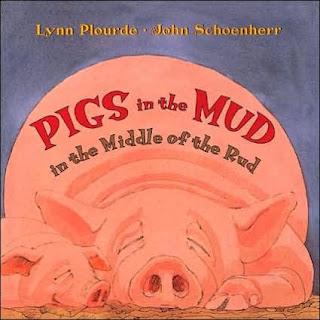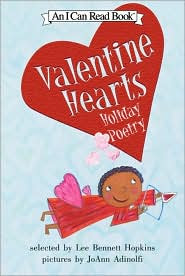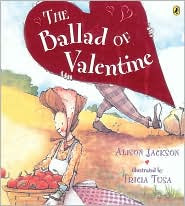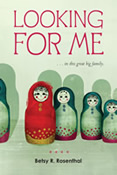new posts in all blogs
Viewing: Blog Posts Tagged with: books in verse, Most Recent at Top [Help]
Results 1 - 9 of 9
How to use this Page
You are viewing the most recent posts tagged with the words: books in verse in the JacketFlap blog reader. What is a tag? Think of a tag as a keyword or category label. Tags can both help you find posts on JacketFlap.com as well as provide an easy way for you to "remember" and classify posts for later recall. Try adding a tag yourself by clicking "Add a tag" below a post's header. Scroll down through the list of Recent Posts in the left column and click on a post title that sounds interesting. You can view all posts from a specific blog by clicking the Blog name in the right column, or you can click a 'More Posts from this Blog' link in any individual post.

Rose, Caroline Starr. 2012.
May B. New York: Random House.
(booktalk)
In Kansas' early days as a state, there is no help in the prairie schools for a child with what will later become known as dyslexia. Nor is there help for a farmer whose spring wheat crop has failed.
So it is neither unforseen, nor unusual when the parents of Mavis Elizabeth Betterly, May B., literally "farm her out" as hired help to a prairie neighbor. Hiram, the Betterly's son, will stay at home, he, being of more use to the frontier family.
The closest homestead is 15 miles away, a full day's journey by wagon. Young May Betterly passes the long hours to the Oblinger's simple, sod house that will be her home until Christmas,
I play a game inside my head,
counting plum trees that dot a creek bed,
rabbits that scatter at the sound of wagon wheels,
clouds that skirt the sky.
For hours, that is all,
and grass,
always grass,
in different shades and textures
like the braids in a rag rug.
Miss Sanders told us that lines never end,
and numbers go on foresver.
Here,
in short-grass country,
I understand infinity.
When Mrs, Oblinger takes a horse and deserts her new husband to return east, Mr. Oblinger goes off in pursuit.
"Don't worry about supper," he says. "I could be gone some time."
"Some time" will be longer than May could ever have dreamed. It will take all of her courage, strength and perseverance to survive.
I am afraid
in the dark
all alone
I am afraid
######
In similar style to Karen Hesse's Newbery-winning,
Out of the Dust, and
Witness, Caroline Starr Rose's novel in verse is deeply affecting. May's honesty in assessing her shortcomings is balanced by her inner optimism that she may yet overcome her situation - against all odds.
We all share that struggle. May B. gives voice and hope to us all.
Teacher's Study Guide for May B.Note: The librarians of the NJLA's Children's Services Section will likely be discussing this book in the upcoming months on our new mock award blog, Newbery Blueberry Mockery Pie. Please join us.

By: shelf-employed,
on 4/26/2012
Blog:
Shelf-employed
(
Login to Add to MyJacketFlap)
JacketFlap tags:
death,
Jews,
J,
books in verse,
based on a true story,
Advance Reader Copy,
family life,
loss,
Depression Era,
Baltimore,
poverty,
poetry,
siblings,
book review,
Add a tag
April is
National Poetry Month, and I realize that I've almost let the month slip away without any poetry book reviews. Just in time, I came across my Advance Reader Copy of
Looking for Me, which went on sale April 17.
Rosenthal, Betsy R. 2012.
Looking for Me. Boston: Houghton Mifflin Harcourt.
Based on the real stories of her mother and
many aunts and uncles, Betsy Rosenthal tells a story in verse of her mother, Edith - the fourth child in a large, Jewish, Depression-era family in Baltimore,
Family Portrait, Baltimore, 1936
We're lined up:
girl boy, girl boy, girl boy, girl boy, girl boy
and in the middle of us all, Dad,
who ordered us to smile
right before the Brownie clicked,
standing stiff as a soldier
no smile on his face,
and Mom's beside him,
a baby in her arms
and in her rounded belly
another one,
just a trace.
Girl, boy, girl, boy, count them up - twelve children in a row house, sleeping three to a bed, always short of money, new clothes and food. Edith's teacher asks her to write about her family, but she doesn't write about herself. After all, who is she in this great big family? Looking for Me chronicles Edith's quest to find individualism in a time when, seemingly, there was no time for such frivolous thoughts. Rosenthal's poetic style varies from free verse, to concrete to metered rhymes. The subject matter varies as well - following the ups and downs of a year in Edith's life, which, while harsh and disciplined, also held moments of great joy and fun,
They're Lucky I Found Them
Lenny, Sol, and Jack
said Mom left them sleeping
on the sofa bed,
or so she thought,
and ran to the store.
But after she left,
they started to bounce
and bounce
and bounce some more.
Then the bed closed up
and they were stuck
until I cam home
and changed their luck.
Some poems are heart-wrenching depictions of life as an 11-year-old Jewish girl who has been touched by death, poverty, meanness, bigotry, and indifference. Others are uplifting,
0 Comments on Looking for Me - a review as of 1/1/1900

By: shelf-employed,
on 7/25/2010
Blog:
Shelf-employed
(
Login to Add to MyJacketFlap)
JacketFlap tags:
YA,
history,
love,
book review,
historical fiction,
romance,
family life,
coming of age,
Pennsylvania,
sisters,
disasters,
books in verse,
society,
floods,
social classes,
coal miners,
Add a tag
Richards, Jame. 2010.
Three Rivers Rising: A Novel of the Johnstown Flood. New York: Knopf.
This book debuted in April 2010 to well-earned,
rave reviews. In sparse verse, author Jame Richards, tells a story of devoted high society sisters, Celestia and Estrella, Whitcomb, their coldly calculating, businessman father, a miner's son, Peter, Maura, the wife of a Pennsylvania railroad engineer, and Kate, an obsessive-compulsive young widow struggling to find a purpose in life. Their lives become intertwined due to the tragically preventable Johnstown, Pennsylvania flood of 1889. Chapters of free-form verse alternate between the voices of the six characters. An author's note separates the facts of the actual flood from the story. More than 2200 people died in the flood, including entire families.
The Johnstown Flood is the backdrop, but
Three Rivers Rising is foremost a story of society, class, and first (or forbidden) love.
Highly recommended for grades 8 and up.
A
reader's guide is available for teachers, librarians and book clubs.
The aftermath of the Johnstown Flood.
(Photograph from
Wikimedia Commons, originally taken by an employee of the National Oceanic and Atmospheric Administration.)
Here are three picture books in verse that I highly recommend. The books have wonderful illustrations that add to the charm and telling of the stories. I just didn’t have time to write about the artwork.

Bear Wants More
Written by Karma Wilson
Illustrated by Jane Chapman
Margaret K. McElderry, 2003
Bear Wants More is a terrific picture book to read aloud at the beginning of spring. In this fine follow-up to Bear Snores On, we find Bear awaking and feeling famished when springtime arrives. Bear leaves his den and looks for food.
He waddles around
and roots all around.
He digs and he paws
fresh shoots from the ground.
He nibbles on his lawn
till the last blade is gone.
But
the bear
wants more!
So bear keeps looking for more...food.
Mouse scampers by and suggests Bear accompany him to Strawberry Vale—where Bear eats and eats and eats…and STILL wants more!
Then Hare comes along and all three animals scoot on over to a clover patch—where Bear nibbles and crunches on his lunch…but he STILL wants more!
Next, Badger shuffles by and takes the animals to an “ol’ fishin’ hole”—where Bear catches fish…and, yes, he STILL wants more!
Meanwhile…Gopher, Mole, Raven, and Wren are back at Bear’s den—decorating it and baking honey cakes for a springtime party for their big friend. Bear smells the scent of something delicious blowing in the breeze. He follows his nose back to his lair—but he’s eaten so much that he can’t fit through his front door. He gets stuck!!!
Badger pries Bear loose with a stick. The animals have their party for Bear outside his lair. Bear’s not finished eating yet. He STILL wants more!
Bear opens presents;
he gobbles honey cakes.
He eats SO much
that his big tummy aches.
He snuggles in the grass
And he snores big snores.
He is full, full, full…
but
his friends
want more!
Look inside this book: http://www.amazon.com/Bear-Wants-More-Karma-Wilson/dp/068984509X#reader_068984509X
Video Clip: http://video.scholastic.com/services/player/bcpid1842760475?bctid=1688281213



VALENTINE HEARTS: HOLIDAY POETRY
Selected by Lee Bennett Hopkins
Pictures by JoAnn Adinolfi
HarperCollins, 2005
This anthology contains twelve poems for the very “young at heart.” Poems in this slim volume were written by such well-known children’s poets as
Rebecca Kai Dotlich,
Marilyn Singer, Lee Bennett Hopkins, and
Ann Whitford Paul. The book also includes a poem by fellow kidlit blogger
Linda Kulp—and two by the widely published author who goes by the pen name of Anonymous.
Valentine Hearts is An I Can Read Book. Its poems are short, lighthearted, and they rhyme. The poems contain few difficult words, are easy to read, and would appeal to most young children. Topics of the poems include a sandwich cut in the shape of a heart that a child finds in his lunchbox, a child getting all covered with glitter and glue when creating a special valentine, a young girl writing a love note to her dog Leo, a chickadee singing a “valentine melody”—and a poem by Maria Fleming about candy conversation hearts that are…
Telling secrets
Spelled in sugared ink:
“Be Mine.”
“For Keeps.”
“It’s True.”
“How Sweet.”
Tiny love notes
Good enough to eat.Here’s a poem from the book written by the famous Anonymous:
Golden Heart
Golden heart
Be on your way.
Go, speed along
To sweetly say
That on this good
St. Valentine’s Day
A heart is meant
To give away.
Valentine Hearts ($3.99 in paperback) would make a good addition to a library collection in an early elementary classroom.

THE BALLAD OF VALENTINE
Written by Alison JacksonIllustrated by Tricia Tusa
Dutton, 2002
In a cabin, in a canyon,
Near a mountain laced with pine,
Lived a girl who was my sweetheart,
And her name was Valentine.
Oh my darling, oh my darling,
Oh my darling Valentine,
I have written forty letters,
But you’ve never read a line.
So begins this lighthearted adaptation of the folksong “My Darling, Clementine.” In this tale, a man attempts to send dozens of love notes to his sweetheart Valentine. Unfortunately, the notes never reach their intended destination—for various reasons. The mailman can’t find Valentine’s address. The homing pigeon flies off to Madagascar. The suitor’s smoky love signal gets blown away by a cyclone. The message tapped out in Morse code hits a blizzard as it crosses the county line.
It matters not that the plucky Valentine hasn’t received any of the amorous correspondence from her beloved. While her frustrated suitor has been trying and trying over and over again to send his notes of love, Valentine’s been busy hanging laundry, feeding chickens, toting well water…and baking an apple pie for her honey—which she delivers to him at story’s end.
It is Valentine’s side of the story that we “read” about only in the illustrations. It’s not written about in the text. The Ballad of Valentine provides a perfect example of how a talented illustrator can extend and enhance a picture book text. With a deft and droll artistic hand, Tusa adds humor and detail to Jackson’s rhythmic and rhyming tale of love. This is a fine and “fun” book to read aloud to young children—make that sing aloud to young children—on Valentine’s Day!
Valentine Poems, Books, & More
Looking for a good picture book to read aloud on Valentine’s Day? Here’s
a link to my review of Sara Pennypacker’s picture book
Pierre in Love that I posted at
Blue Rose Girls some time ago.

********************
At Blue Rose Girls, I have a poem by the late John Updike entitles Burning Trash.
The Poetry Friday Roundup is at Wild Rose Reader today. Leave a comment and the URL of your poetry post at the roundup post.
The following books have rhyming texts and would be wonderful for reading to very young children at this time of year. They are fine ways to introduce little listeners to rhyming words and rhythmic language.

SNOWY, BLOWY WINTER
Written by Bob Raczka
Illustrated by Judy Stead
Albert Whitman & Company, 2008
Raczka’s zippy text and Stead’s bold and colorful illustrations take us through the chill and sights of winter days and nights and common seasonal activities—icicles hanging from eaves, snow swirling through the air, sliding down hills, making snow angels, shoveling, making a snowman, feeding birds. They also take us through the warm indoor happenings—sipping hot cocoa, having a hot bath, reading by the fire, baking cookies.
This is a picture book where the pictures help to “tell” readers what the spare text
doesn’t. Some pages have no words. The other pages have just one, two, or three words—with the exception of the last two pages. The final page includes all the “fun” words
Raczka used to describe
Snowy, Blowy Winter. This would certainly be an enjoyable book to share with youngsters and could be used as a springboard for having them add their own words to describe winter.
Here are some excerpts from the book:
Snowy,
blowy,
windows are glowy.
Strappy,
zippery,
icy and slippery.
Angels are lovely.
Sidewalks are shovely.
The back matter of the book has a recipe for “Snowy, Blowy Ice Cream.”

MILLIONS OF SNOWFLAKES
Written by Mary McKenna Siddals
Illustrated by Elizabeth Sayles
Clarion, 1998
This small book is perfect for lap reading. It is also a counting book for little ones just beginning to learn about numbers.
The book begins…
One little snowflake
falls on my nose.
It makes me shiver
from my head to my toes.
Two little snowflakes
get in my eyes.
Blink! Blink!
What a surprise!
And so the text goes—from a child counting two snowflakes to counting three and four and five snowflakes and then to looking at snow all around her:
Snow on the house.
Snow on the tree.
Snow on the grounds.
Snow on me!
Millions of snowflakes in my hair.
Snowflakes falling everywhere!
Sayles’ illustrations work perfectly with Siddals’ text. The first picture is a small square surrounded by a thick white border. As the book progresses, the pictures get larger and larger until the end of the book. Then the borders are gone and the illustrations fill up the pages—just as the child’s world is filling up with snow.
Sayles’ illustrations are uncluttered and spare. The focus of the pictures is the snowflakes and a young Asian child with her dog enjoying the falling—and fallen—snow. The illustrations have warm, purplish and or peach backgrounds. This is a lovely little winter book to share with a very young child.

TRACKS IN THE SNOW
Written & illustrated by Wong Herbert Yee
Henry Holt, 2003
Tracks in the Snow is another small picture book—just right for lap reading. It has more text than the previous two books that I reviewed here. In this book, a young Asian girl sees some mysterious tracks in the snow and wonders what animal might have made them. She goes looking. She skips around the old oak tree, walks by the frozen pond, crosses a snowy bridge, peeks under a log, tramps up a hill. She finally realizes that it was she who left the tracks. She made them the day before when she was out playing in the snow.
The book has a lovely rhythmic text that is written in quatrains with a rhyme scheme of ABCB—except for the refrain.
The Refrain:
Tracks in the snow.
Tracks in the snow.
Who made the tracks?
Where do they go?
Here’s another excerpt from the book. In this quatrain the child is thinking to herself and trying to solve the mystery of who made the tracks in the snow:
It could have been a duck,
But I think they’ve gone away.
I know it’s not a woodchuck;
They sleep all night and day.
Wong Herbert Yee’s illustrations done in Prismacolors on Arches watercolor paper have a soft, blurry look. They are set against a white background and capture the feel of a wintery country world blanketed with snow. This quiet picture book is a keeper!
********************
At Blue Rose Girls, I have a special Elizabeth Alexander post that includes links to her inaugural poem Praisesong for the Day and to videos of her poetry reading at the inauguration, Jeffrey Brown’s conversation with her on the Newshour with Jim Lehrer, and her appearance on The Colbert Report.
Laura Salas has the Poetry Friday Roundup this week.

I hadn’t planned to write a book review for
Nonfiction Monday. I was looking for a poem to post for
Presidents’ Day in honor of
George Washington when I remembered a book I used to share in the library with my elementary students—a book I still read to the students in my children’s literature course. It’s a nonfiction book about the dental problems that our first President faced, the constant pain caused by his rotting teeth, and the dentures that were made for him. It isn’t a typical book about one of the most illustrious figures in American history. It’s a humorous story written in verse that begins at the time of the Revolutionary War and ends after George Washington becomes President and gets a pair of dentures carved from a hippo tusk.
 GEORGE WASHINGTON’S TEETHWritten by Deborah Chandra & Madeleine Comora
GEORGE WASHINGTON’S TEETHWritten by Deborah Chandra & Madeleine Comora
Pictures by Brock Cole
Farrar Strauss Giroux, 2003
George Washington’s Teeth is most certainly a great book to read aloud! It’s rhythmic and rhyming and sure to tickle children’s funny bones. But…the book was well researched. In the back matter, there is a four-page time line (1732-1799) of important events in Washington’s life taken from his own letters, diaries, and accounts. It includes two photographs of his last set of dentures. There is also a list of time line sources.
This is how the book begins:
The Revolutionary War
George hoped would soon be won,
But another battle with his teeth
Had only just begun…
George Washington rushed into town,
The dentist heard his shout.
“Hold still,” he said, then gave a yank—
A rotten tooth popped out!
But that’s not the end of George’s tooth troubles. He heads off to war again with another toothache. He has swollen gums, which he soothes with oil of myrrh. He continues to lose teeth and have teeth pulled. He has to eat soft foods like mush and pickled tripe. When he crosses the Delaware River, there are just nine teeth left in his mouth. At Valley Forge, he has but seven. By the time he returns home after the war is won, he can count the number of teeth in his mouth on one hand: five. So it goes…until Election Day, when…
Poor George had two teeth in his mouth
The day the votes came in.
The people had a President,
But one afraid to grin.
When an artist comes to paint George’s portrait, he has the President put cotton in his mouth to puff out his sunken lips. Later, his dentist brings him a set of dentures. The denture’s springs snap against his tongue, fly out of his mouth—and he loses his last tooth. Poor “toofless” George gets an idea. He rummages through Mount Vernon looking for the teeth he lost. He makes a plaster mold with the teeth he finds to show to the dentist. The dentist then carves Washington a set of dentures from hippo tusk. The rhyming story ends happily with George dancing the night away at a ball.
In the book’s time line, the authors state the following: “George dies at Mount Vernon at the age of sixty-seven. It is believed that a chronic, untreated infection from the old root fragments in his gums contributed to his death.” There are many other facts included in the time line—as well as pictures of some of Washington’s portraits—that children are sure to find interesting.
Brock Coles’ cartoon-like watercolor illustrations enhance the lighthearted tone of the text. Children are sure to enjoy this humorous tale of the dental woes of the Father of Our Country.
Edited to Add:
To see a picture of a set of George Washington’s dentures, click here.
To see two more pictures of George Washington’s teeth, click here and here.
Anastasia Suen has the Nonfiction Monday Round-up for February 18, 2008.

By: Rebecca,
on 12/17/2007
Blog:
OUPblog
(
Login to Add to MyJacketFlap)
JacketFlap tags:
strangers,
isay,
an,
act,
favorite,
pogue,
thesmokinggun,
manual,
goldberg,
listening,
book,
love,
of,
is,
Blogs,
iphone,
A-Featured,
Prose,
storycorps,
Add a tag
Last year to celebrate the holidays we asked our co-workers what their favorite books were. This year we asked some of our favorite people from all around publishing. They were kind enough to take a few minutes in this busy holiday season to share with us. To thank them I am going to make it my goal to read all of their suggestions by next year. Throughout the week we will be sharing favorite books from our favorite people so be sure to check back for updates and let us know what your favorite books are in the comments!
Andrew Goldberg is the Managing Editor of Thesmokinggun.com.
While this has not been a banner year for me when it comes to the quantity of books I have made it through–I have read a few that are entertaining, funny, informative, and moving. (more…)
Share This
Apologies in advance, but I just had to share this....
As of today the Jesus Storybook Bible, that I illustrated for most of last year, has just hit #26 on the MOVERS AND SHAKERS on amazon.com! It's also currently at a sales rank of 433....






















I loved this one! I reviewed it on my blog a while back. I hope it will be on the Printz short list, but I can never predict what those committees will like. Maybe it could win the Scott O'Dell since it's set in the U.S.?
I agree. It's certainly worth the committee's consideration - a great book! One Crazy Summer offers some competition, though!